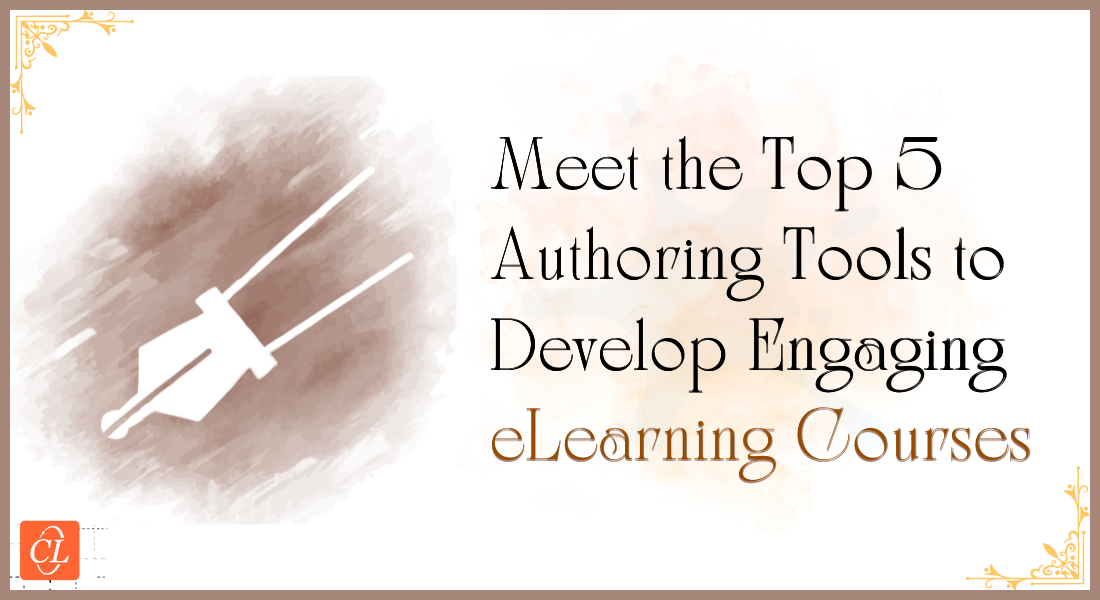4 Most Popular eLearning Authoring Tools in 2022

The technologies are constantly evolving and upgrading to serve to match the forever-changing comfort zones of people. The eLearning industry is no different and needs to be upgraded constantly to keep the learners engaged. Authoring tools are one such technology that keeps getting upgraded constantly to meet the learner’s requirements and to ease out the development process for eLearning course developers. Choosing the correct eLearning authoring tool depends on several factors such as the quality of eLearning output, scalability, speed, and efficiency.
In this blog, I will talk about what eLearning authoring tools are, the features and importance of authoring tools, and the 4 popular eLearning authoring tools in today’s era.
Trouble Deciding the Authoring Tool to Use for Your eLearning Course Development?
Here are the 4 most popular authoring tools you can choose from
- Adobe Captivate
- Elucidat
- Articulate Storyline 360
- Lectora
Know more about each of the mentioned tools below
What are Authoring Tools?
Authoring tools are simply the software that is used to create digital content. eLearning authoring tools assist the creator to generate and play around with multimedia resources as per the content’s intention. Authoring tools can either be desktop-based or online cloud-based where both have their own pros and cons.
These tools are mostly used by instructional designers in an organization to develop eLearning courses for their employees. The courses developed through the authoring tools can be used for a variety of purposes like onboarding assistance, upskilling and reskilling of employees, compliance training, etc.
A few learning management systems have pre-built-in authoring tools that are very basic and restrict the authors to an extent. Whereas, other tools are built to provide a wide range of options to instructional designers that support their creativity and eventually help them create a customized and effective eLearning course. Authoring tools support formats such as SCORM, HTML5, xAPI(TinCan), LTI, etc.
Are you looking to convert your legacy courses into HTML5 as well? We can help!
Importance and Features of eLearning Authoring Tools
Importance
- Allows you to adopt a learner-centered approach for eLearning through personalized content.
- Allows the in-house team, authors, subject matter experts (SMEs), and stakeholders to work together easily.
- Makes it easy for organizations to update the legacy courses with new information and make it accessible globally with the support of eLearning translation tools embedded within these authoring tools.
Features
- User-Friendly interface
- Ready-made templates
- Interdepartmental-Collaboration capability
- Multi-device accessibility
4 Popular eLearning Authoring Tools
1. Adobe Captivate
Adobe Captivate is one of the most powerful authoring tools in the market that is used for the creation of eLearning courses such as simulations, software demonstrations, scenarios, and randomized quizzes in HTML5 format. You can create beautiful, fully responsive courses within a limited time because of the feature-rich nature of Captivate. Adobe Captivate is a desktop application that is available for both Mac and Windows OS and provides a free trial of 30 days before you buy their subscription.
Pros
- Ability to produce complex interactions.
- Geo-location makes the output aware of its corresponding location.
- Ability to recognize basic mobile gestures like zoom, swipe, pinch, etc.
- Quick access to ready-to-go slides.
- Ability to create virtual reality walkthroughs for experiential eLearning.
- Useful for simulations and screen recording.
Cons
- Steep learning curve due to the presence of a lot of advanced features.
- Still supports FLASH despite the format being obsolete.
- Review and update processes are time-consuming and require excess effort due to Captivate being desktop-based.
2. Elucidat
Elucidat is a cloud-based eLearning authoring tool available for both Mac and Windows OS that is extremely user-friendly apart from being useful for both, small and large eLearning developers and instructional designers. A variety of strategies like gamification, scenario-based learning, and polls can be used for maximizing learner engagement. eLearning course developers get access to a huge library of pre-built templates to help newbies create engaging courses. Apart from built-in templates, the creator also gets an option to create their own page layout without coding.
Pros
- Ready-made templates for faster course creation.
- Access to an extensive range of interactions and features.
- User-friendly WYSIWYG interface
- Ability to collaborate at ease due to cloud-based nature, flexible permissions, and user roles.
- The analytics dashboard provides detailed data on learner engagement that helps to optimize the course accordingly.
- Advanced yet easy translation process.
- Ability to create custom packages as per your desired requirements.
Cons
- Can be time-consuming to get a hold of all the features provided.
- Expensive as it neither provides a free trial nor discloses its price publicly.
3. Articulate Storyline 360
Articulate Storyline 360 is the most popular authoring tool to create interactive and modern eLearning courses that are responsive. It has 1000+ pre-built templates, and themes along with an easy-to-use review tool that helps the stakeholders to learn and understand the created courses. Storyline 360 is a windows-based authoring app that has a modest learning curve due to its flexible nature. It is equally helpful for experts and new creators because of its versatility and extensive library. Storyline 360 offers a 30-day free trial before you opt for its paid subscription model.
Pros
- Highly flexible and provides great control while creating courses.
- A widely used tool that has a huge and highly active community
- Access to a wide range of custom resource libraries such as stock images and templates.
- Enables translation into multiple languages easily.
- Access control and role-based permissions allow the stakeholders to actively participate in the creation of on-demand courses.
- Ability to include several design strategies along with brand integration.
Cons
- Doesn’t allow mobile app and third-party integrations.
- Collaborations can be time-consuming because of its desktop-based nature.
- Can be expensive if the number of authors are more.
4. Lectora Inspire & Lectora Online
Lectora is the most versatile eLearning authoring tool among every other tool discussed till now. Lectora is extremely user-friendly as it is available as both, a cloud-based tool and desktop-based software. Lectora helps you design, deliver and publish courses across various platforms and multiple devices. Lectora also has access to a wide range of pre-built templates, layouts, and interactions that helps in the creation of a full-fletched course with ease. Lectora Online provides automated reviewing and revisioning so your team and stakeholders can work together in a collaborative environment.
Pros
- Ability to create content on multiple devices with the help of its responsive slider.
- Fabulously modern UI
- Extremely flexible
- Conditional Branching & Sequenced Events for personalized eLearning
- Includes an error check feature that points out any issue before releasing the final output.
- Offers a powerful translation tool where you copy materials from one language to another.
Cons
- Limited support and a sharp learning curve.
- The interface is modern and fascinating but not that friendly.
- A lot of its advanced features are not Section 508 compliant.
Honorable Mentions
Although I listed the most popular authoring tools, there are other tools as well that can be helpful as per specific requirements, some of the other considerable tools are
- Articulate Rise 360
- Gomo
- Adapt
- Easygenerator
- iSpring Suite
- Camtasia
Final Thoughts!
There are a lot of eLearning authoring tools and every tool has its own pros and cons where each pro or con is relative to the L&D team’s desires and intentions. Instructional designers can use any of the authoring tools mentioned above as their requirements because one tool has an edge over the other in a specific domain but might fall short in other important domains. For example, Adobe Captivate is the most powerful tool but lacks a user-friendly nature whereas Articulate Storyline 360 is the most user-friendly but Lectora is better than any other tool when it comes to versatility.
Among these multiple authoring eLearning tools, choosing the right tool can always be challenging and can affect your learning program and ultimately your business if you choose the wrong tool or misunderstand your requirements. If you are still confused about which authoring tool to use, our free eBook can be your friend.





